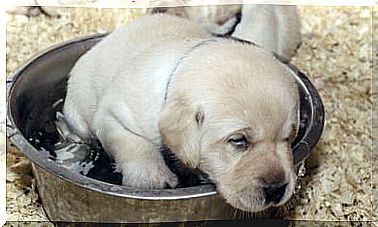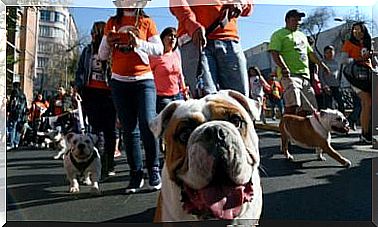Food Allergies In Animals: How To Recognize Them?

Food allergies in animals are among the most complex and, in some ways, stimulating diagnostic challenges that a veterinarian can face. When there is a suspicion that an animal may suffer from this type of allergy, it is necessary to work hard to try to find the root of the problem.
Why are food allergies in animals so complex to detect? What symptoms do they produce in a pet? Below we will explain everything you need to know about this immune process.
Types of food allergies
For educational purposes, and to better understand the diagnostic process of food allergies, we will briefly explain all types of allergies that exist. Let’s start:
- Food allergy : the one we deal with. When the allergen, that is the element that causes the allergy, is present in a food.
- Environmental allergy : In this type of allergy, the allergen is found in the environment.
- From contact : the easiest to diagnose. It happens when the allergy is caused by a specific element, such as a certain collar or food bowl.
- Flea bite allergy : As the name suggests, the bites of these parasites trigger an allergic reaction in the animal.
This classification may seem obvious and not very important, but you will understand later that it is not. Especially considering that animals can suffer from combinations of all these allergies.
Foods involved in food allergies in animals
Not all foods have the same ability to cause a food allergy picture on a pet. While it is true that virtually any substance has allergic potential, there are some foods that are more involved in developing this process.
Chicken and beef are among the protein substances with the greatest allergenic potential. While, in the cereals sector, we find in particular corn and wheat.

How do you know if an animal has a food allergy?
There is no easy answer to this question. Remember the types of allergies listed above? Unfortunately, with the exception of contact allergy, which has a more local reaction, all other variants have similar symptoms.
Also, for added complexity, food allergies can develop at any time and at any age. Many pet owners reject the food allergy option, claiming that the pet has eaten the same type of food all its life.
Unfortunately, this statement doesn’t help much. In fact, an animal can develop an allergy suddenly, even if it has eaten that food all along. As surprising as it may seem, these spontaneous allergies do not only occur in dogs, but have also been documented in humans.
The same reasoning also applies to environmental allergies. In fact, even this type of reaction can develop unexpectedly. For all these reasons, if the animal suddenly starts scratching, there is no apparent way to know the cause.
Diagnostic approach
To identify this pathological process, an approach based on clinical signs is first adopted, which are usually rather nonspecific. Among the most frequent are:
- Itching and scratching.
- Red skin.
- Skin rashes.
- Conjunctivitis.
- Vomiting and diarrhea (sometimes).
- Self-induced alopecia, especially in cats.
These symptoms lead the veterinarian to suspect the existence of an allergic pathological process. However, to know the cause it is necessary to continue to investigate. The time has come to use more complex detection methods.
Currently, diagnostic tests are available on the market based on the interpretation of the quantities of immunoglobulins, which are the allergy-mediated substances present in the blood. These methods, while having great potential, may not be very reliable at the moment, especially in cats.
Elimination test
This method of diagnosing food allergies in animals involves exclusion from the most suspicious foods. For example, if the animal has been eating chicken and rice food for several months, it is best to choose meals that do not contain these components.
There is also the option to prepare a menu at home, without resorting to ready-made foods. Or think of specially formulated hypoallergenic diets. The latter give very good results in most cases, but as a disadvantage we can mention their high cost.
If you use ready-made foods, it is necessary to give the animal its new diet for at least two months, and exclusively that type. We emphasize the concept of exclusivity, as if the pet consumes, for example, commercial sweets, there may be interactions that will mask the results.
It is also advisable to keep the new diet for a long time in order to observe the results. If the animal responds and the symptoms improve, it is time to reintroduce the previous food in search of a new allergic reaction. If a new reaction occurs, the food allergy has been diagnosed.

We hope that you have found this article interesting and that you have a better understanding of the complex diagnostic process for detecting food allergies in animals. The first step in treating any disease is, in all cases, for the owner to detect it promptly.









